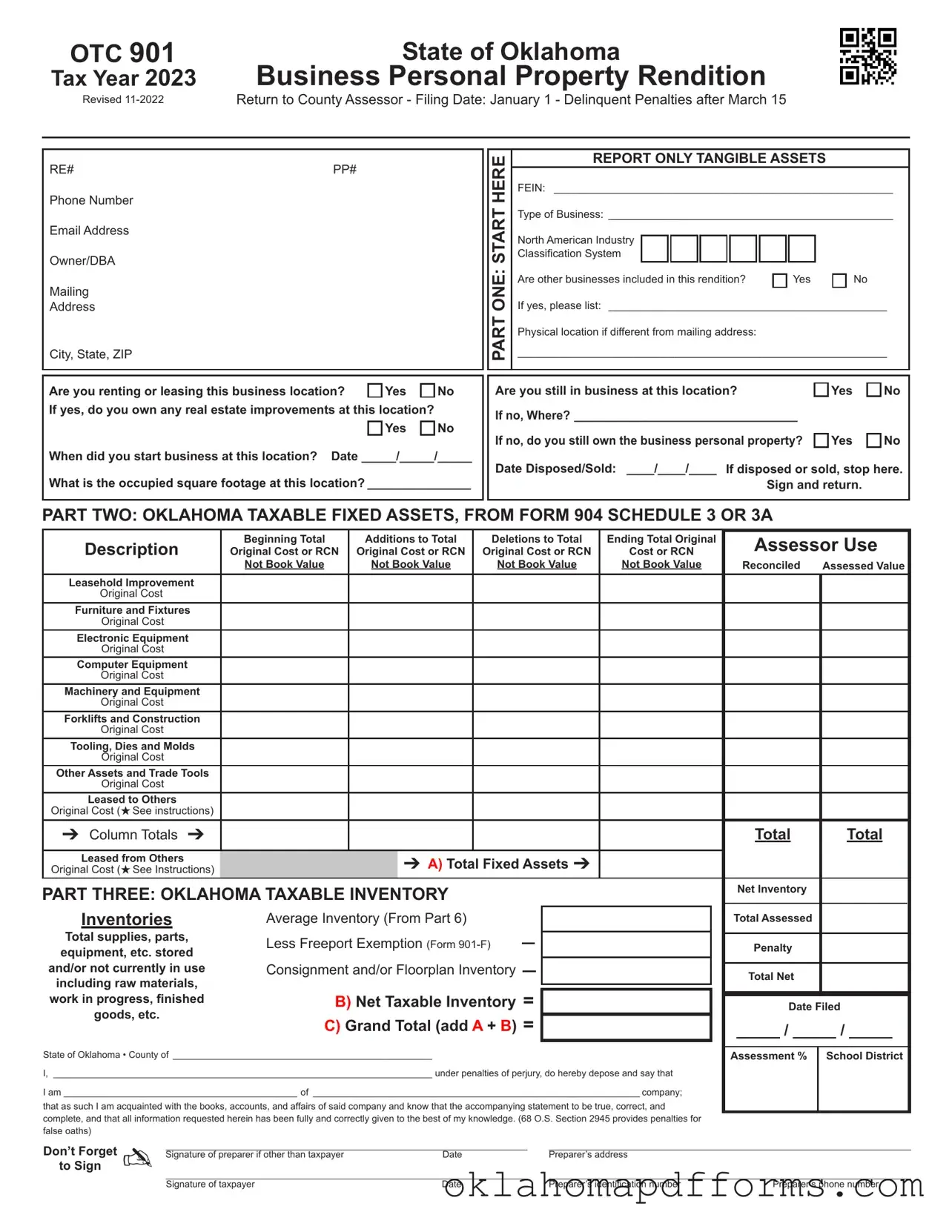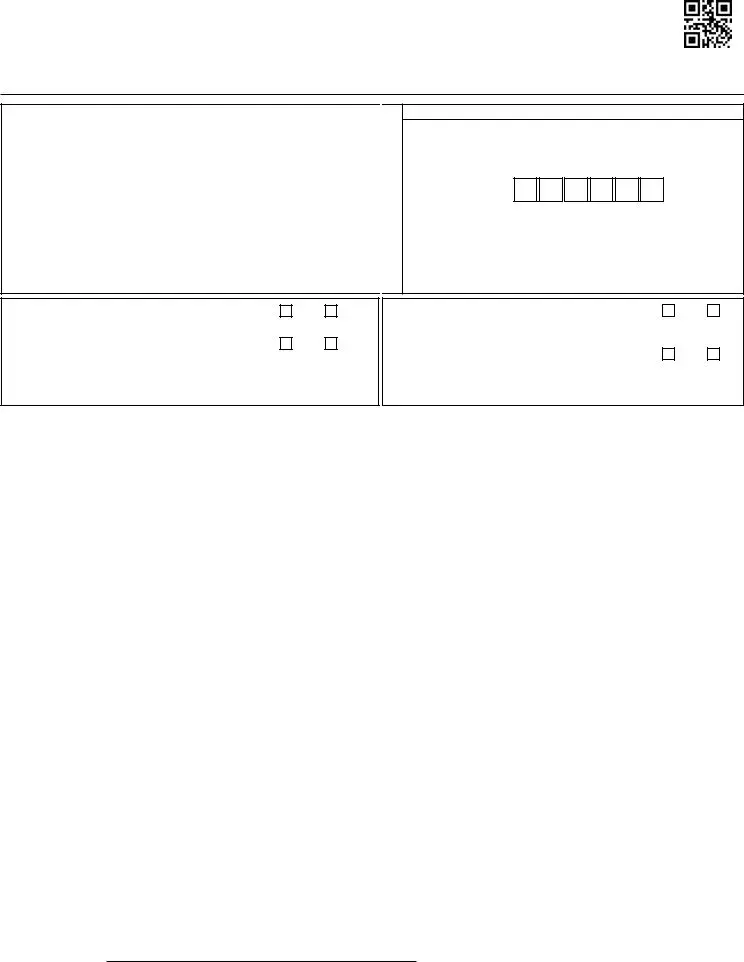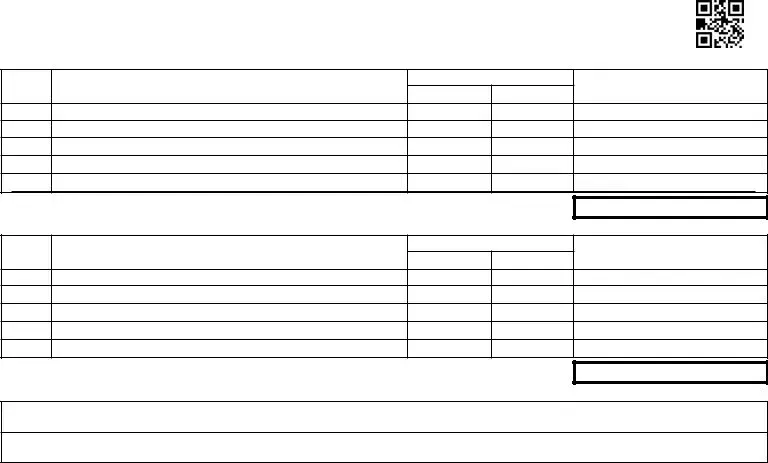Who Must File...
All business concerns, corporations, partnerships and professionals are required by Oklahoma statutes to file each year a statement of taxable assets as of January
1, which are located within this county. This rendition must be signed by an owner, partner, officer of the corporation or a bonafide agent.
Penalties...
Failure to file by March 15th will subject the taxpayer to a mandatory penalty of 10 percent, or a 20 percent penalty if not filed by April 15th (68 OS Sec. 2836C). If received through the mail by this office, it must be postmarked no later than March 15th. Postage metered mail overstamped by the Post Office after March 15th, will carry the mandatory
penalty.
Taxpayers Filing Form 901 in this County ...
Attach a complete detailed listing of all TANGIBLE assets used in business, grouped by description, year acquired and original cost, and items that have zero book value, use reporting Asset Listing 904 Schedule 3 or 3A, which is available from the county assessor. Report ONLY TANGIBLE ASSETS.
North American Industry Classification System (NAICS)...
This is your six digit Federal Business Activity Code.
Location of Property...
You must file a separate rendition for each location for assessment allocation to the
various school districts.
Original Cost Values or RCN...
Report the total new or used total cost or replacement cost new, including freight-in and installation costs. Do not deduct investment credit, trade-in allowances or depreciation. If unknown, estimate the original cost. Estimated costs will not be depreciated without supporting documents.
Year Acquired...
This is the purchase date. Depreciation cannot be calculated unless the year acquired is reported.
Leasehold Improvements...
Report cost and detailed description of improvements to property owned by others. Do not report building expansions or repairs, rough plumbing or electrical service, which are included in real estate values. Report all other items such as partitions, new store fronts, etc.
Furniture and Fixtures...
Items included: office desks, chairs, credenzas, file cabinets, table booths, shelving display cases, racks, gondolas, retail fixtures, hotel and motel furnishings, apartment
appliances, etc.
Electronic Equipment ...
Items included: calculators, copiers, drafting machines, blueprinting machines, fax machines, postage machines, telephone equipment, typewriters, lunch room appliances, etc. Also, include electronic and computer controls used with machinery and equipment.
Computer Equipment ...
Items included: computer hardware, monitors, drives and other such hardware compo- nents, custom software is exempt as an intangible.
Machinery and Equipment...
Items included: auto repair, agricultural, bakeries, barber and beauty shops, cleaning and laundry, fuel storage tanks, gas pumps, medical, restaurants, signs, theaters, etc.. All equipment and machinery (forklifts, mobile yard cranes, drilling rigs, tools) is also included. Equipment installed on trucks or trailers after purchase must also be reported. Do not list licensed vehicle such as autos, trucks, semitrailers, boats over 10 h.p., etc.
Forklifts and Construction Equipment...
Items include: forklifts, back hoes, compactor, dozers, draglines, earth movers, graders,
mobile cranes, rollers, trenchers, etc.
Tooling, Dies and Molds...
Items include: Tooling, dies, punches, molds, patterns, jigs, etc.
Trade Tools and Equipment...
Include items used by carpenters, cement finishers, craftsmen, electricians, mason,
mechanics, repair services, roofers, etc.
★Leased to Others...
List lessee, address, asset type, original cost, and age of asset. Additional sheets may be attached if necessary.
★Leased from Others...
List lessor, address, asset type, age of asset, and beginning year of lease. Additional sheets may be attached if necessary.
Inventories...
Add your total monthly inventories. Then divide the sum by the number of months you have inventory in this county for the year to determine your average inventory. Inventories held for others or cosigned must be reported separately. Inventory claimed exempt must be accompanied by a Freeport Exemption Form (901-F). Companies primarily engaged in
selling of lumber and other building material including cement and concrete except for home centers classified under Industry No. 444110 of the North American Industrial Classification Systems (NAICS) Manual, shall be assessed at the average inventory value on hand each January, 1 and December, 31 of the same calendar year.
If the Business is Sold, Closed or Name Changed...
To avoid possible incorrect or duplicate assessment, taxpayers should provide information as follows:
•Business Sold: date of sale, name and address of new owner.
•Business Closed: date of closing or date all personal property was disposed, report location and value of any remaining property still owned on the assessing date, even if in storage.
•Business Name Change: date of change and new name.
Intangible Business Personal Property...
If any intangible property is imbedded in the reported assets the intangible property must be identified and valued to the county assessor with supporting documentation. Supplemental
Form 901-IP must be used for any submission.



 PART ONE: START HERE
PART ONE: START HERE